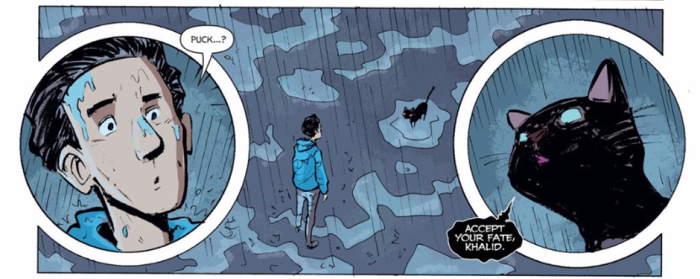The Vanier Report: Week 22
 Doctor Fate #1
Doctor Fate #1
Written by: Paul Levitz
Pencils and Inks by: Sonny Liew
Colours by: Lee Loughridge
Letters by: Nick J. Napolitano
I think it really says something about the new direction of Doctor Fate that writer Paul Levitz and artist Sonny Liew are credited simply as “Storytellers”. The new series’ debut as part of DC’s post-Convergence “story over continuity” editorial move seems to take that notion to heart, calling back to the looser continuity of oral traditions and classical mythologies; essentially, to storytelling.
In Doctor Fate #1, the world is on the verge of being flooded by Anubis, the Egyptian god of the dead. As heavy rains and flooding begin to hit Brooklyn, Bastet – the Egyptian protector god – reveals herself to Khalid Nelson, an Egyptian-American medical student descended from the Pharaohs of old, and offers him the helmet of Fate. After initially refusing, Khalid is thrust into the role of hero when he saves a girl from a subway train and finds that he is now surrounded by mystical forces. He accepts Bastet’s gift and becomes the new Doctor Fate.
This is a number one issue that is mostly set up. Levitz introduces the basic premise of the first arc, sets up the relationship between Anubis and Bastet, and briefly explores some of Khalid’s newfound powers. The main story is also intercut with scenes of Khalid’s girlfriend, mother, and father; establishing them as supporting characters but otherwise feeling rather superfluous. In general, these asides feel like they’re just filling pages as opposed to really fleshing out who these secondary characters are, but an ominous twist at the end of the issue is a promising sign that the seemingly innocuous may be what is most important.
Sonny Liew’s artwork is fascinating. His thin figures and sketch-like penciling feel extremely organic. I will freely admit that I’m actually quite partial to DC’s “house style”, but only because it suits the tone of traditional superhero stories. Liew’s art would feel out of place in Geoff Johns’ “Darkseid War” arc, but in Doctor Fate, it helps to remove the narrative from the usual superhero tropes and reimagine the Lord of Order as a character firmly entrenched in Egyptian mythology.
Ultimately, the strength of this new Doctor Fate series is that mythological influence. I made a comment in my write up before the issue was released that placing Doctor Fate within the context of Egyptian mythology was akin to Azzarello’s run on Wonder Woman, in which nearly all of the narrative action took place in the settings and between the characters of Greek mythology. This Wonder Woman was successful for two reasons:
- It wasn’t forced – Diana and the Amazons have long shared a history with the Greek pantheon, so placing Wonder Woman in the realm of the Olympian gods felt like a return to something instinctive in the character, even though it had never been explored quite so thoroughly before.
- It shifted the mode of storytelling – Making Diana’s adventures about Greek mythology did more than introduce new settings and characters, it altered the way in which Wonder Woman’s mythos was explored. The punching and lassoing were incidental to some incredible, primal questions regarding Diana: can a being of peace be the God of War? What does it mean to embody War? Can the immutable realities of the natural world (as embodied by the Olympians) change or evolve or adapt? In short, Wonder Woman became as much a story about the fundamental nature of the world as it did about Diana.
Levitz and Liew’s Doctor Fate has the potential for both of these key factors. There has always been a connection between Doctor Fate and Egypt, most notably the character’s trademark ankh symbol. Granted, Fate has never been woven so deeply into the mythos of the Egyptian gods before, but there is enough history to make that relationship work. Secondly, and most importantly, Levitz and Liew have already begun removing their Doctor Fate from traditional superhero fare. What I hope to see through this arc and through this series is an exploration of what it means to be a Lord of Order. How does one impose or preserve order in a chaotic universe? Can it be done? Should it be done?
What I see in Doctor Fate #1 is the potential for a whole new understanding not only of one of the oldest and most esoteric heroes in the DC Universe, but also a new understanding of the forces at work in that universe. Mythology and oral tradition use their characters to plumb deeper meanings about the world we live in. That’s not to say the characters and stories aren’t interesting in their own right, but we are encouraged to participate and not just consume.
This first issue was mostly set up, but I believe that Levitz and Liew are going to take their “storyteller” credits to heart and give us a really exciting addition to the mythology of Doctor Fate.
________________________________________________________
Feature Written By: Reid Vanier
![]()
“Reid is a comic book fan masquerading as a theatre artist. His love of comics (specifically DC) was inherited by his father’s collections of Flash, Superboy and the Legion of Super-Heroes, and Justice League of America. Reid is now the Editor and Lead Writer of Modern Mythologies.”



